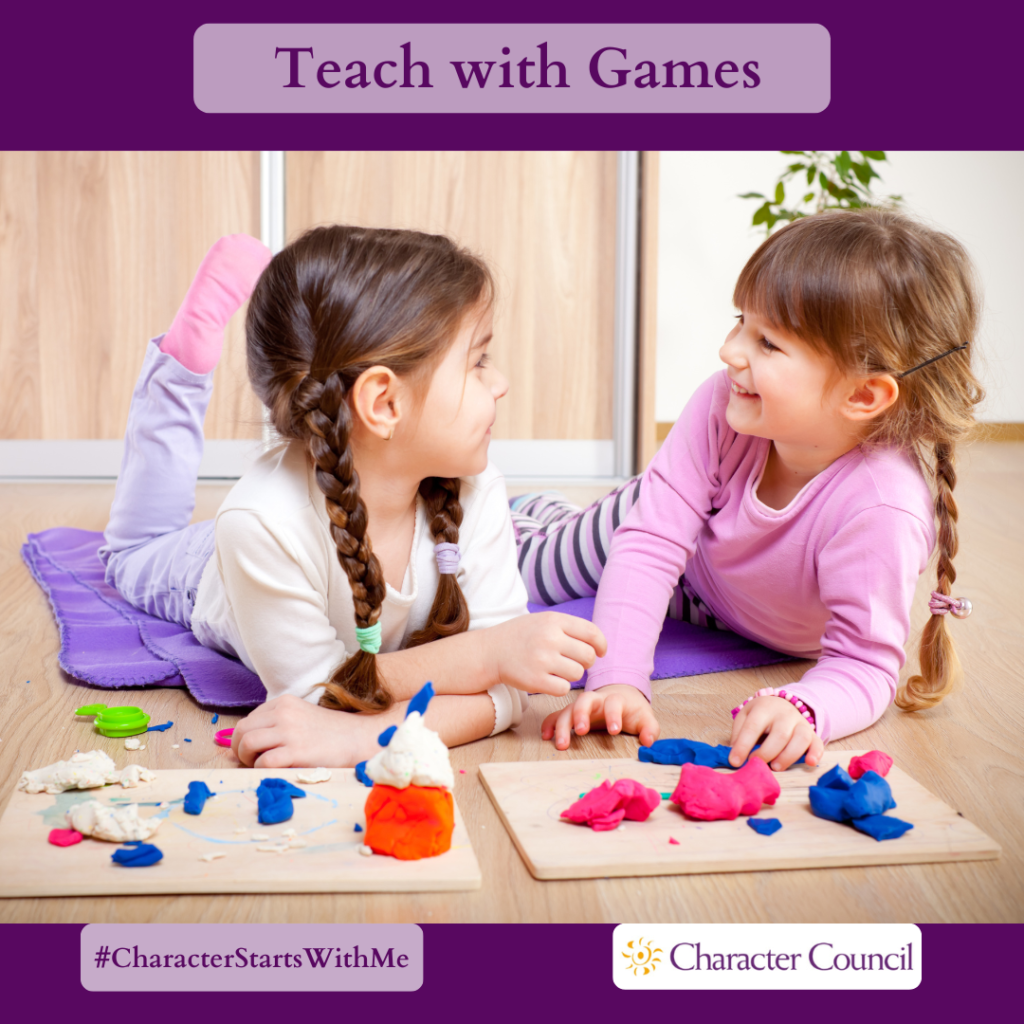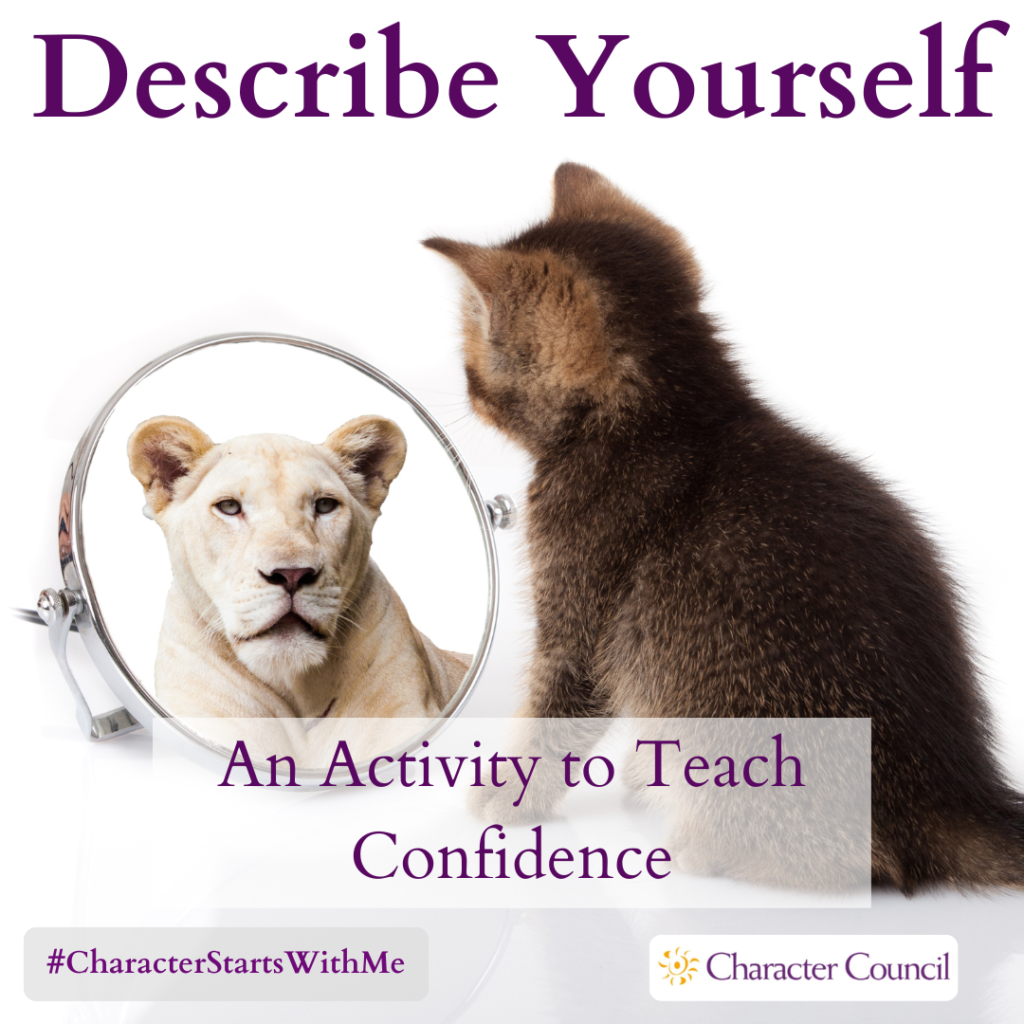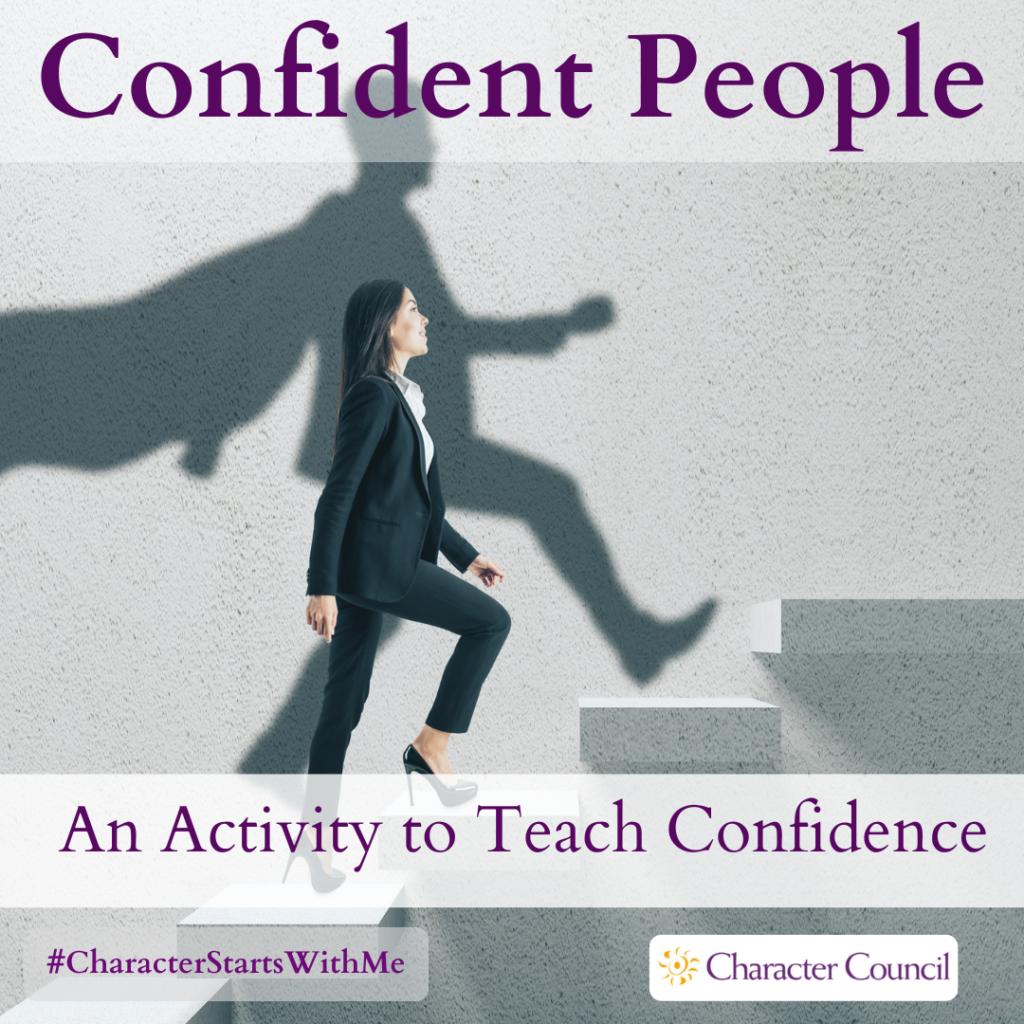
Confidence Activities
The activities here are fun ways to teach character. The game aspect makes the lesson more memorable. Each activity has processing questions at the end. Without processing the activity, the exercise is just a game. To make it a stronger lesson when you process it, relate the character quality to a core value that your organization promotes.
Consider picking a student to run the activity. You will need to give them time ahead of the activity to prepare. Another option is to pick a few students to run the activity for a younger classroom after you have run it for your class. Encourage your students to repeat it in the home for younger siblings or even parents.


Describe Yourself
Instruct the students to rip a piece of paper into ten strips. On 5 of the strips, they should write a character quality that describes themselves. You can limit it to the ones on our website or not limit it. On the other 5 strips, they should write a skill they are good at – not perfect, but good.
Have them lay out all 10 strips face up. They must pick one quality to “give up”. They will turn over the paper with this quality on it. Then, they choose a skill to give up and turn that paper over. Do this round several times so that they continue to turn over qualities. If time allows, you can do all 10. Ask them to think about how their life would be different if they didn’t have those qualities or skills. How would that affect their decisions, their activities, or their relationships? Walk them through regaining each of the qualities/skills, one by one. Ask them how it feels to have those back.
To process the activity, ask these or similar questions:
- Did you like this exercise? Was it hard to come up with your qualities and skills?
-
How did it feel to give up a quality? Was that different than a skill?
- Did you think about how you could get it back? Did you think about another quality or skill you could replace it with?
-
How did it feel to get it back? Was there comfort in that?
-
Are you more aware of your qualities and skills now that you have done an inventory?
-
Are there any qualities or skills that you would like to add to your list? (You can add them in your head.)
-
Will you remember this exercise as you proceed through the day/week? Will you be more sensitive to how the qualities and skills that you wrote down are evident in your life?

Affirmations
An affirmation is a positive statement that you repeat to yourself to change your mindset and achieve your goals. Affirmations can improve your self-confidence, boost your motivation, and overcome negative thoughts. When you repeat an affirmation, you are essentially telling yourself that you believe in yourself and your ability to achieve your goals. This can help to change your mindset and create a more positive outlook on life.
As a class exercise, you can convert the ‘I will’ statements into affirmation statements. (Directions and Tips are below) You can divide the class into groups and assign an ‘I will’ to each group. Do not assign the last one to a group. If you have more than 4 groups, it is okay to have more than one group working on the same ‘I will’. You can also have each group write an additional affirmation relating to anything age-appropriate. Have each person write an affirmation based on the last ‘I will’. At what do they want to be successful? They can work in the group and help each other write the last one.
If you have younger students, you can use the list below as ideas. They may be able to add to the list. Have them choose 1 or 2 they can repeat daily.
Directions for writing affirmations:
- Start by identifying what you want to change. What are your negative thoughts or beliefs that you want to challenge? What are your goals that you want to achieve?
- Turn your negative thoughts into positive affirmations. Instead of saying, “I am not good enough,” say, “I am worthy of love and success.” Instead of saying, “I will never be able to do that,” say, “I am capable of anything I set my mind to.”
- Write your affirmations in the present tense. This will help you feel as if you are already living the desired reality. For example, instead of saying, “I will be confident,” say, “I am confident.”
- Use strong, positive language. Avoid using words like “try,” “might,” or “could.” Instead, use words like “know,” “believe,” and “will.”
- Make your affirmations specific and measurable. Instead of saying, “I am happy,” say, “I am happy with my job, relationships, and health.”
- Repeat your affirmations regularly. The more you repeat your affirmations, the more they will sink in, and the more likely you are to believe them. You can repeat your affirmations out loud, write them down, or listen to them on a recording.
- Be patient and persistent. It takes time and effort to change your negative thoughts and beliefs. Don’t get discouraged if you don’t see results immediately. Just keep repeating your affirmations, and eventually, you will see a difference.
Here are some additional tips for writing affirmations:
- Use words that resonate with you. The more personal and meaningful your affirmations are, the more likely you are to believe them.
- Keep your affirmations short and simple. This will make them easier to remember and repeat.
- Make your affirmations believable. You’re less likely to see results if you don’t believe your affirmations. So, make sure your affirmations are realistic and achievable but
- If you want to stop a bad habit, use language that paints a positive visual picture of what success looks like. For example, if you want to stop biting your fingernails, your affirmation could be: “I have long, beautiful nails.” If you wrote about a bad habit, such as “I will stop biting my nails,” then the picture your brain makes is biting your nails, which is not what you want to accomplish. Which picture do you want in your brain?
- Visualize yourself achieving your goals. When you repeat your affirmations, take a moment to visualize yourself already having achieved your goals. This will help you to feel more confident and motivated.
- Have fun with it! Affirmations should be a positive and uplifting experience. Be creative. Add superhero motions if they add to your affirmation. Say it as if you are proclaiming it on stage. Hum theme music (Do kids these days know the theme song from Rocky???) If you’re not enjoying yourself, you’re less likely to stick with it.
Ideas for Younger Students
- I am a smart kid.
- I can learn new things.
- I am creative.
- I am a good friend.
- I like to help others.
- I try new things.
- I am kind.
- I treat others with respect.
- I am loved, and I am important.
- I can reach my goals.
- I am happy.
- I am a good reader.
To process the activity, ask these or similar questions:
- Did you like learning about affirmations?
-
Was it difficult to write everything in the positive?
-
How did it feel to say positive statements?
-
Do you think if you repeated them enough, you would believe it?
-
The next time a negative thought about yourself enters your head, do you think you could use an affirmation to knock it out?

Confident People
To understand the difference in the outlook of those who are confident vs. those who doubt their self-worth, the class will categorize each of the following items as typical of confidence or doubt. You will read from each list but mix them up. The class can either say what they think it is, or you can have them move to the confident side of the room or the doubting side of the room when you read each one. When you are done, read the list of Confident People again to plant those images in their mind.
Confident People
- Celebrate other people’s success
- Open-minded
- Optimistic
- Willing to take risks
- Laugh at themselves
- Decisive
- Always learning and growing
- Admit mistakes
- Accept responsibility
Doubting People
- Judge and are jealous of others
- Close-minded
- Pessimistic
- Afraid of change
- Hide flaws
- Indecisive
- Act like a know-it-all
- Make excuses
- Blame others
This list came from VeryWell Mind
When finished, process the activity with these or similar questions:
- Did you like this game?
- Were the questions difficult?
- How much of the confidence list do you see in yourself?
- If you find yourself doing the behaviors associated to being doubtful, do you think you could think positively and bolster your confidence?